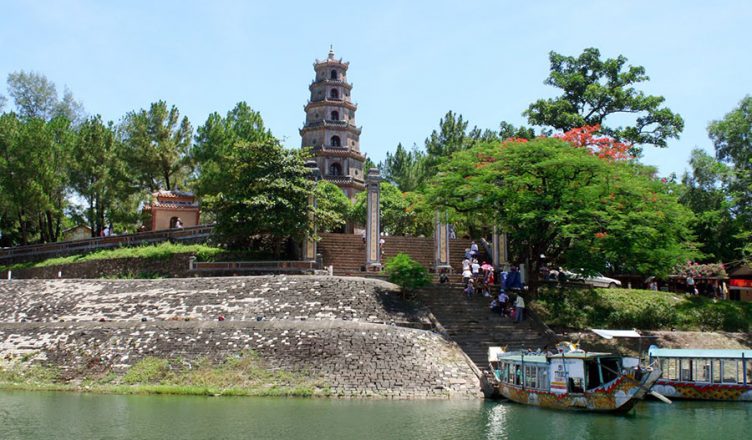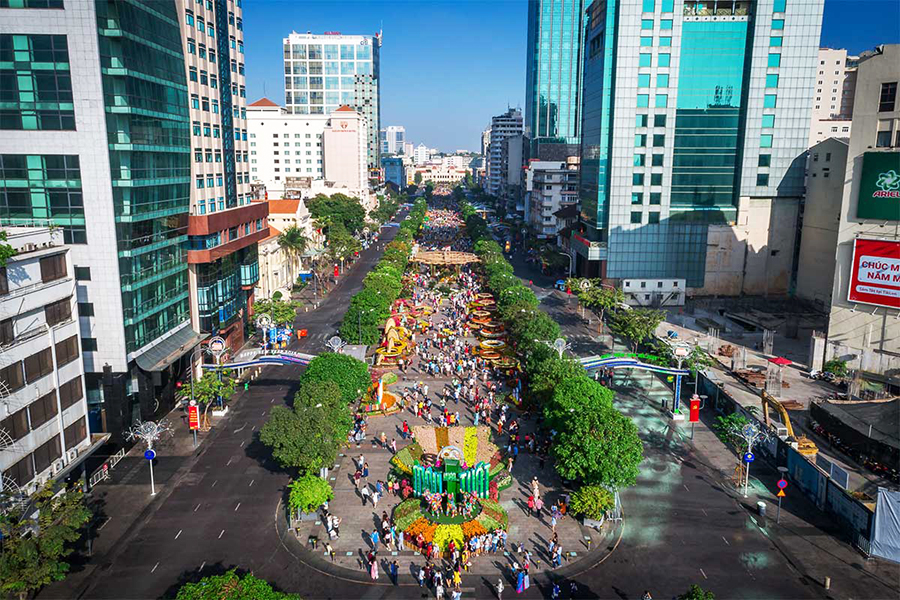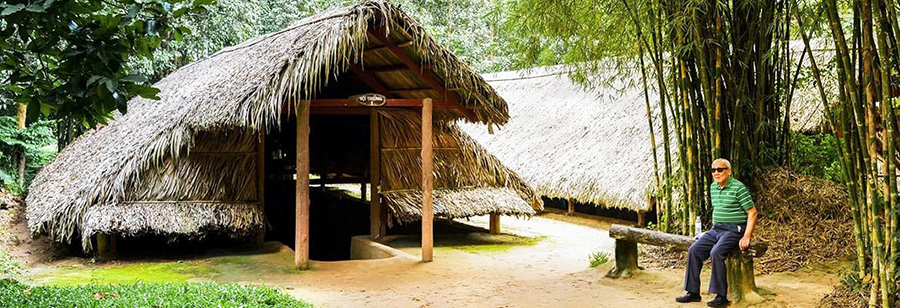Hue City is the place that gathers a number of tourist attractions. However, the most ancient one would go for Thien Mu Pagoda – one of the destinations that are mentioned most when tourists visit Hue. Not only is the pagoda taken as a symbol in myriad numbers of romantic poetries or lyrical songs, but it is also regarded as the most sacred and attractive pagoda that no visitor should miss on their Vietnam Shore Excursions or Vietnam Tour Package.
Where is Thien Mu Pagoda Located?
Thien Mu Pagoda is also known as Linh Mu Pagoda, is one of the most fascinating and ancient pagodas in Hue city. Thien Mu Pagoda was built on Ha Khe hill, on the north bank of the Perfume River Hue, in Huong Long village, 5 kilometers from Hue city, which is easy to reach from the city center.
Location: Huong Long village, North bank of Perfume River – 5 km from Hue city center
The name of the pagoda derives from a special legend. Long time ago, an old woman appeared on the hill where the pagoda stands today, telling local people that a Lord would come and build a Buddhist pagoda for the country’s prosperity. Lord Nguyen Hoang therefore ordered the construction of the pagoda the “Heaven Fairy Lady” or Thien Mụ in Vietnamese (also called Linh Mụ). Thanks to such a mysterious history, the pagoda has attracted a great number of tourists from both inside and outside of the nation to come and explore the legend themselves.
- You may be interested in our Hue Tour from Da Nang, Hue Private Tour Half Day, Hue Street Food Tour or DMZ Tour Hue.
Thien Mu Pagoda Entrance Fee
It is free to visit Thien Mu Pagoda Hue. So, you should not miss this place when you visit Hue City. Here is a great destination for you to understand more Buddhism in Vietnam. What you just need to pay is for the parking lot near the Thien Mu pagoda. It costs about VND 5,000 for a bike and VND 10,000 for a scooter.
Thien Mu Pagoda Opening Hours
It is quite easy and flexible about the opening hours at Thien Mu pagoda. If you would like to avoid the crowd and have good views take some beautiful photos and get out of the hit. You should visit Thien Mu Pagoda Hue Vietnam from 6 am to 8 am. If you would like to enjoy the beautiful moments of Sunset on the Perfume River at the sacred Pagoda de Thien Mu, you should be here at 6 pm.
Highlights of Thien Mu Pagoda
Formation and Growth
The beautiful pagoda was built in 1601. Later on, several kings of the Nguyen Dynasty such as Gia Long, Minh Mang, Thieu Tri and Thanh Thai, all had the pagoda restored. At this very initial time, Hoang was the governor of the province of Thuan Hoa (now known as Hue), yet, started ruling his independent state in central Vietnam.
According to the royal annals, Hoang was on a sightseeing trip and holiday to contemplate the seas and mountains of the local area when he passed by the hill, which is now the site of the Thien Mu Pagoda. On hearing the mentioned local legend, he had the pagoda constructed. The initial temple was in a very simple form of construction, but as time went by, it has been redeveloped and expanded with more intricate features.
A Special Architectural Site
The most striking feature of the pagoda, Phuoc Duyen tower (initially called Tu Nhan tower), was erected in 1884 by King Thieu Tri, and has become the unofficial symbol of Hue. This octagonal tower has seven storeys (2m high), which is dedicated to a Buddha who appeared in human form. It is the highest stupa in Vietnam, and is often the subject of folk rhymes and ca dao about Hue, such is its iconic status and association with the city. More importantly, it is regarded as the unofficial symbol of the former imperial capital.
To the left of the tower is a pavilion sheltering an enormous bell. The bell, called Dai Hong Chung, was cast in 1710 by Lord Nguyen Phuc Chu. It is famous for its great size, which is 2.5m high and 3,285 kg. It is considered to be an outstanding achievement of 18th century bronze casting.
To the right of the tower is a pavilion containing a stela dated from 1715. It is set on the back of a massive marble turtle, a symbol of longevity, and is 2.58 m high.
Besides, there are several popular works of art inside the pagoda, which are of great captivation to tourists. For instance, Dai Hung shrine, the main-hall, which presents a magnificent architecture. As bronze cast statues, it shelters some precious antiques: the bronze gong cast in 1677, the wooden gilded board with Lord Nguyen Phuc Chu’s inscriptions (1714).
Historical Role of Thien Mu Pagoda
Besides the architectural value, Thien Mu pagoda features a great historical role, which is also of absorption to visitors. During the summer of 1963, Thien Mu Pagoda, like many in South Vietnam, became a hotbed of anti-government protest. South Vietnam’s Buddhist majority had long been discontented with the rule of President Ngo Dinh Diem since his rise to power in 1955. Diem had shown strong favoritism towards Catholics and discrimination against Buddhists in the army, public service and distribution of government aid.
Discontent with Diem exploded into mass protest in Hue during the summer of 1963 when nine Buddhists died at the hand of Diem’s army and police on Vesak, the birthday of Gautama Buddha. Accordingly, Buddhist protests were held across the country and steadily grew in size. In those historical days, Thien Mu Pagoda was a major organizing point for the Buddhist movement and was often the location of hunger strikes, barricades and protests.
Today, the pagoda is surrounded by flowers and ornamental plants. At the far end of the garden stretches a calm and romantic pine-tree forest. It is well-maintained and very welcoming to all visitors.
What to see at Thien Mu Pagoda?
Phuoc Duyen Tower
From a high altitude, the holy pagoda looks like a giant dragon is turning its large back. From the Perfume River, it is easy to see Phuoc Duyen Tower. It was a birthday gift from Tu Duc Emperor offered to his grandmother in 1844. One special thing about this tower is that there is a statue of Buddha placed to face the south on every floor. Ongoing inside the tower, you can see a spiral staircase leading to the top floor where a golden Buddha statue was previously on display.
Giant Turtle and Dai Hung Chung Bell
Looking around in the left and right corners, visitors can enjoy the beauty of the giant turtle, made of marble in 1675. As you know, Turtle is one of the four holy animals in Vietnam. The symbol of longevity and education. So that’s why some students, before taking examinations, come here to touch the head of the turtle to get good luck. The stele on the back of the turtle is a commemoration of Lord Nguyen Phuc Chu’s renovation.
The text inscribed on the stele, penned by the Lord, portrays the new buildings of the pagoda and praises Buddhism, as well as the monk, who helped the Lord spread the faith throughout the region.
On the left-hand side, there is a pavilion featuring a huge bronze bell, named Dai Hong Chung. Casted in 1710, the bell’s dimensions make it one of the most significant achievements in bronze casting in Vietnam at that time. It weighs nearly 6,000 pounds, is 4.5 feet high, and is audible up to 6 miles far away.
Three-Door Gate and Dai Hung Shrine
Entering the Three-door gate with 12 holy guardians, we will reach Dai Hung Shrine. The sanctuary shrine is where people pray and worship three Buddha statues, symbols of the past, present, and future, three lives of human beings. It is also the place where Buddhist monks’ worship.
Austin Car and The Stupa
Walking to the backyard, we will see a beautiful rockery. It is for decoration but also to be an air conditioner. To make the weather cooler in summer and warmer in the winter. There is a large yard with many fabulous bonsai trees. Each monk in the pagoda takes care of one. A bit further, there is an Austin car. The car of Thich Quang Duc Monk who burnt himself in 1963 against the Ngo Dinh Diem Regime. Asking for the freedom of people to follow Buddhism.
The last one in the pagoda is the stupa. The grave of the first head monk Thich Don Hau. Following the tradition, when normal people died, we put them in coffins to bury. But to the monks, we do the cremation.
Thien Mu Pagoda Map
How to get to Thien Mu Pagoda Vietnam?
You can get to Thien Mu Pagoda Hue Vietnam by different ways. The first is to take a dragon boat to Thien Mu Pagoda. You will have a great chance to enjoy the beautiful landscapes along the Perfume River. Moreover, you can ride a bike, or drive a motorbike, or even go for a walk to get there. Besides, if you wish to enjoy the most authentic experience, you can book a Hue City Tour or Hue Shore Excursions via Vietnam Shore Excursions.
For sure, you will have unforgettable memories and wonderful experiences to make your holiday better. Therefore, you should add this place to your travel list before travelling to Vietnam.


















